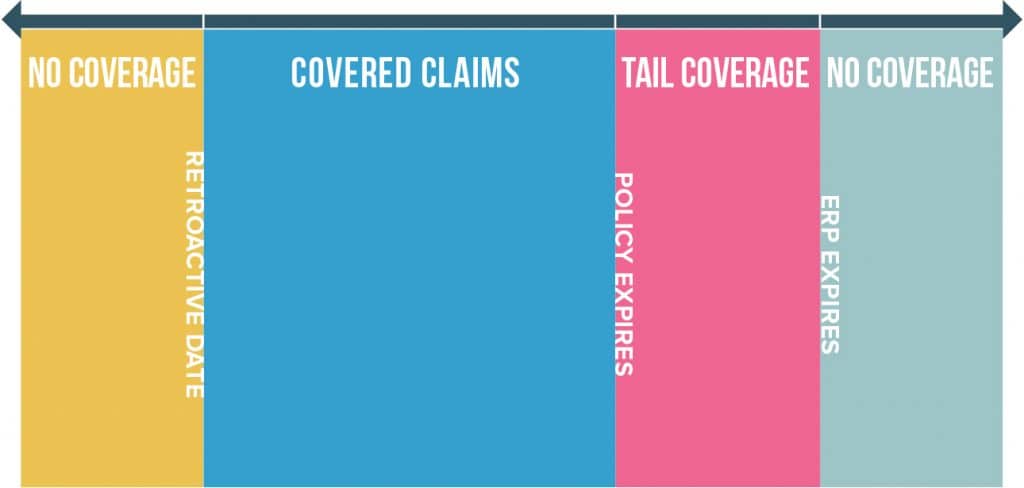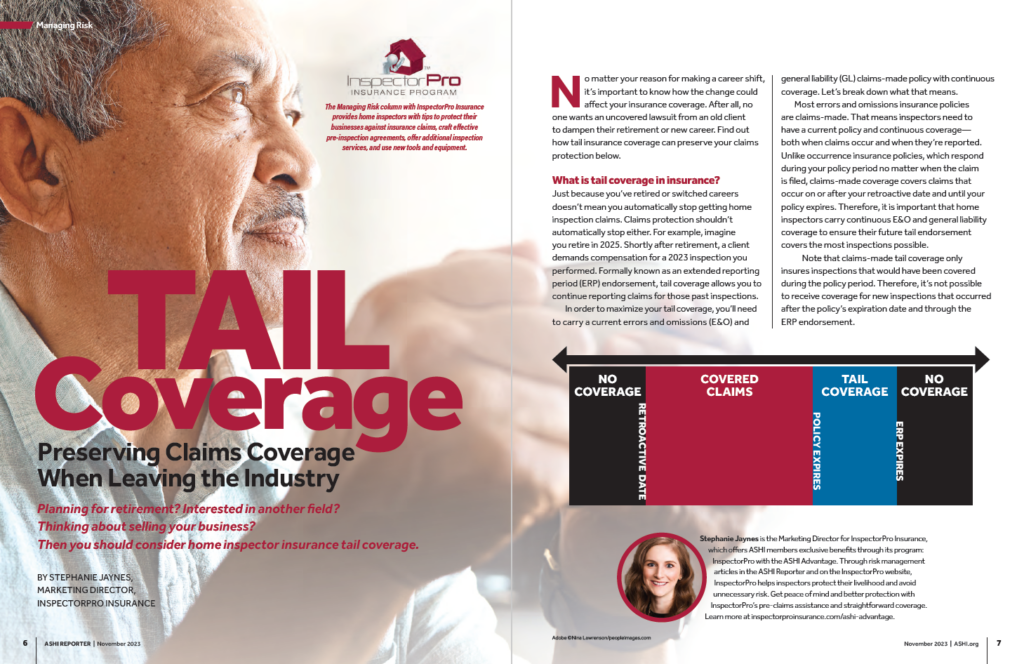Tail Coverage: Preserving Claims Coverage When Leaving the Industry
Last Updated February 16, 2024


Planning for retirement? Interested in another field? Thinking about selling your business? Then you should consider home inspector insurance tail coverage.
No matter your reason for making a career shift, it’s important to know how the change could affect your insurance coverage. After all, no one wants an uncovered lawsuit from an old client to dampen their retirement or new career. Find out how tail insurance coverage can preserve your claims protection below.
What is tail coverage in insurance?
Just because you’ve retired or switched careers, doesn’t mean you automatically stop getting home inspection claims. Claims protection shouldn’t automatically stop either. For example, imagine you retire in 2025. Shortly after retirement, a client demands compensation for a 2023 inspection you performed. Formally known as an extended reporting period (ERP) endorsement, tail coverage allows you to continue reporting claims for those past inspections.
In order to maximize your tail coverage, you’ll need to carry a current errors and omissions (E&O) and general liability (GL) claims-made policy with continuous coverage. Let’s break down what that means.
Most errors and omissions insurance policies are claims-made. That means inspectors need to have a current policy and continuous coverage—both when claims occur and when they’re reported. Unlike occurrence insurance policies, which respond during your policy period no matter when the claim is filed, claims-made coverage covers claims that occur on or after your retroactive date and until your policy expires. Therefore, it is important that home inspectors carry continuous E&O and general liability coverage to ensure their future tail endorsement covers the most inspections possible. (Click here to learn more about claims-made vs occurrence coverage.)

Note that claims-made tail coverage only insures inspections that would have been covered during the policy period. Therefore, it’s not possible to receive coverage for new inspections that occurred after the policy’s expiration date and through the ERP endorsement.

How do you get tail coverage?
When a home inspector is ready to leave the industry, their business, or their franchise, they let their insurance company know. Typically, inspectors purchase extended reporting period endorsements at the end of their policy period and in lieu of their insurance renewal.
If the policy’s still effective when you want to leave the industry and purchase tail, your provider will cancel your current policy, and your tail endorsement will begin on that same cancellation date. If the inspector lets their insurance lapse at renewal, the inspector may still have time after the policy expires to purchase tail coverage. Review your policy or ask your insurance broker for their tail purchasing deadline.
How long does tail coverage last? When purchasing tail coverage, you often have options. Typically, ERP endorsements offer one- to five-year terms of coverage. How long do you need tail coverage? The number of years you purchase depends on your individual risk tolerance. (To learn about risk tolerance, see the conclusion of our article on insurance limits here.) However, there are a few other things to consider when making your decision:
- Once you’ve bought tail, you can’t extend the coverage. For example, if you buy one year of tail, you can’t buy a second year at the end of that term.
- Whatever option you decide often has to be paid in full.
- Some home inspection franchises have minimum tail insurance coverage requirements. If you’re a franchise owner, check to make sure you fulfill those requirements.
Once your policy expires and your tail coverage goes into effect, you cannot perform additional inspections and receive coverage under that same expired policy. If you receive claims during your endorsement period, you will report them to your insurance company as you would normally. When your tail coverage policy expires, so does your protection.
Tail Coverage with the ASHI Advantage
Typically, the cost of tail coverage depends on how much you purchase. Most insurance providers offer anywhere from one to five years of tail for a percentage of premium—usually 100 to 300 percent of what you pay annually for insurance while actively inspecting. However, if you’re looking to offset your tail coverage cost, look no further than your ASHI membership.
As a member of the American Society of Home Inspectors (ASHI), you have exclusive access to InspectorPro with the ASHI Advantage. Through this members-only program, ASHI inspectors can receive great benefits like a premium credit, cheaper inland marine equipment coverage, and five free years of tail coverage.
Five years of free tail coverage is a huge, unprecedented benefit. Based on typical insurance policy premiums, the average ASHI home inspector can save around $6,000 by opting in to the ASHI Advantage and its free tail coverage. That can be the difference between being able to take a vacation (or two) after retirement and being unable to afford to travel.
To qualify for the free tail, members must meet the following criteria:
- Carry insurance with InspectorPro for three or more consecutive policy periods (at least 36 months).
- Be age 55 or older.
- Opt-in, in writing, no later than 60 days after their policy’s expiration or cancellation.
- Not be subject to any disciplinary proceedings regarding their inspection services.
Don’t wait until you’re close to retirement to sign up for the ASHI Advantage. ASHI members can benefit from receiving better coverage for less cash. New inspectors, too, can receive $250 off their first year of coverage.
 How can tail coverage protect me?
How can tail coverage protect me?
We asked members of the inspection community to weigh in on the importance of home inspector tail coverage.
It protects you and your clients.
According to Paul Duffau of Safe@Home Inspections, LLC in Washington, tail insurance coverage is an essential risk management tool.
“I’ve had inspector friends chasing the next, latest deal on insurance without realizing that they had opened a door to risk by not carrying tail coverage,” Duffau said. “It’s critical to have tail coverage, both to protect your retirement and to protect your clients, when you retire…. The modest cost for the coverage is more than worth the reduction in risk.”
Remember, tail coverage goes beyond safeguarding you when you retire. So long as you still meet the qualification requirements mentioned earlier, it can protect you if you become disabled or die prior to retirement, too.
It protects you during a vulnerable time.
The year after you retire is a time you and your business are particularly susceptible to potential claims. Most clients complain within a year of their inspection, so having a tail coverage policy for the most recent inspections you performed is essential.
“It seems, if someone runs into an issue, it is usually 90 days to a year after the inspection,” Brian Persons of Front Range Home Inspections in Colorado said.
It protects you from your worst-case scenarios.
When selecting tail insurance coverage, our home inspectors’ preferences vary. While a year of tail coverage is the most common purchase, some inspectors think it’s wise to opt for more.
“Tail coverage [helps] ensure protection of what [you] have built and saved,” said Jim Troth of Habitation Investigation, LLC in Ohio. “Even if it is frivolous, that claim could come in right near the end of your coverage for your first year of retirement.”
Dan Howard of Howard Building Testing & Inspections, LLC of Pennsylvania agreed.
“PA law establishes a one-year past the date of inspection window for clients to sue inspectors for errors In the cases of ‘gross negligence.’ Longer statutes of limitations apply,” Howard said. “Why have insurance, [including tail coverage]? I like my house, and the weather in PA is too cold for me to live in a tent if I get sued for everything I own.”
Read more about managing risk through contract provisions, like the statute of limitations, here.
Make your decision with the future in mind
Do I need tail coverage? Is tail coverage worth it? None of us can predict the future, so your choice depends on how much you’re willing to leave to chance. In addition to many other benefits, InspectorPro with the ASHI Advantage gives you an extended reporting period without the additional cost. If you haven’t already, use your ASHI membership to apply for the ASHI Advantage today to save now and when you retire.
The ASHI Reporter published this article in November 2023. See how this story appears in print below.






